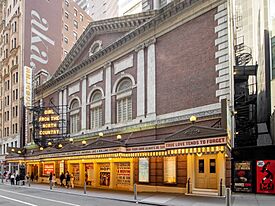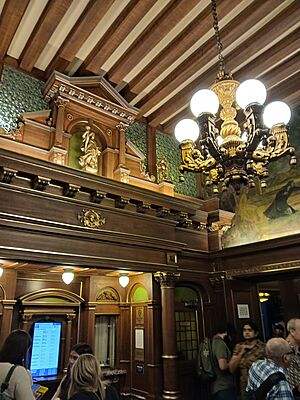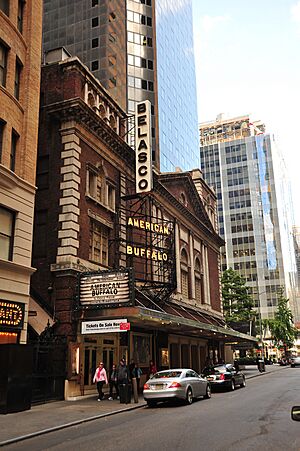Belasco Theatre facts for kids
|
Stuyvesant Theatre
|
|

The Belasco Theatre in 2022
|
|
| Address | 111 West 44th Street Manhattan, New York United States |
|---|---|
| Coordinates | 40°45′24″N 73°59′02″W / 40.75667°N 73.98389°W |
| Owner | The Shubert Organization |
| Type | Broadway |
| Capacity | 1,016 |
| Production | Maybe Happy Ending |
| Construction | |
| Opened | October 16, 1907 |
| Architect | George Keister |
| Website | |
| shubert.nyc/theatres/belasco/ | |
| Designated | November 4, 1987 |
| Reference no. | 1317 |
| Designated entity | Facade |
| Designated | November 4, 1987 |
| Reference no. | 1318 |
| Designated entity | Lobby and auditorium interior |
The Belasco Theatre is a famous Broadway theater located at 111 West 44th Street in Midtown Manhattan, New York City. It first opened in 1907 as the Stuyvesant Theatre. It was designed by architect George Keister for the famous theater producer David Belasco.
The theater can seat 1,016 people on three levels. Since 1948, it has been owned by The Shubert Organization. Both the outside and inside of the theater are protected as New York City landmarks because of their historical and artistic importance.
The front of the building is made of red brick with detailed terracotta decorations. Above the main theater, there is a ten-room apartment where David Belasco once lived. The inside of the theater is known for its beautiful Tiffany light fixtures, detailed woodwork, and large murals painted by artist Everett Shinn.
When Belasco died in 1931, other people took over the theater. The Shuberts bought it in 1948 and even leased it to the TV network NBC for a few years. It returned to showing live plays in 1953 and has been a home for Broadway shows ever since.
Contents
Designing a Grand Theater
The Belasco Theatre was designed by architect George Keister in a style called neo-Georgian. This style was chosen to look like many of New York City's early government buildings. The theater was named after Peter Stuyvesant, an important leader of the Dutch colony that later became New York City.
Compared to other theaters of its time, the Belasco is smaller and more intimate. It was built with offices and dressing rooms in a separate wing. In 1909, a private two-story apartment was added on top for David Belasco.
The Building's Exterior
The front of the theater on 44th Street is made of red brick and terracotta. It is divided into two parts: the main theater entrance on the east and an office section on the west.
At the ground level, several pairs of doors lead into the theater. A large metal canopy hangs over the entrance to protect guests from the weather. Above the ground floor, the building's design is not symmetrical. The office section has its own unique windows, while the main theater section has three large bays with arched windows on the third story. A triangular top, called a pediment, sits above the center of the building.
Inside the Theater
The interior was designed to be beautiful and advanced for its time. It featured special lighting, a powerful hydraulic system for the stage, and plenty of space for sets and scenery. The lighting fixtures were designed by the famous Tiffany Studio.
The color scheme inside was mostly shades of blue, green, and brown. The theater also had modern heating and cooling systems that used a special space under the floor to spread air evenly, so there were no noisy radiators.
The Lobby and Auditorium
The entrance lobby is a small, square room with mosaic tile floors and marble walls. The main ticket window is at the back of the lobby, set inside a decorative arch.
The auditorium, where the audience sits, has a main floor called the orchestra and two balconies. The space was designed so that every seat has a clear view of the stage. The walls are decorated with wood panels, and beautiful stained-glass light fixtures hang from the ceiling.
The stage is framed by a decorative proscenium arch. Inside the arch is a large mural painted by Everett Shinn. The stage itself was very advanced. It had a large elevator trapdoor that could lift entire sets from two basement levels below. This allowed for quick scene changes.
David Belasco's Apartment
The ten-room apartment built for David Belasco was as unique as the theater itself. It had its own private elevator and a living room with a 30-foot-high ceiling. Belasco filled the apartment with his collections, which included ancient glass, art, and books. After he died, many of these items were sold at an auction.
History of the Belasco Theatre
During the early 1900s, Times Square became the center of New York's theater world. David Belasco, a producer known for his focus on amazing stage lighting, wanted to build a theater where he could control every detail.
The Belasco Era
The theater was developed by Meyer R. Bimberg and opened on October 16, 1907, as the Stuyvesant Theatre. The first show was a musical called A Grand Army Man. Critics loved the new theater, calling it "the most complete and satisfactory playhouse in existence."
In 1910, Belasco renamed the theater after himself. For the next 20 years, he produced many successful shows there. He was known for helping several actresses become stars, including Katharine Cornell and Lenore Ulric. Belasco was famous for his attention to detail. For one play, he insisted on having a working laundry on stage that could wash and iron real clothes.
After Belasco's death in 1931, the theater was run by others. The Group Theatre staged several important plays there in the 1930s, including Awake and Sing! and Dead End. Dead End was a huge hit and ran for 684 performances.
The Shubert Years
The Shubert Organization bought the Belasco Theatre in 1948. For a short time, from 1949 to 1953, they leased it to NBC, which used it as a TV studio. After that, it returned to being a home for Broadway plays.
Through the 1950s and 1960s, the Belasco hosted many notable productions. The 1960 play All the Way Home won the Pulitzer Prize for Drama. In 1969, actor Al Pacino made his Broadway debut at the Belasco in the play Does a Tiger Wear a Necktie?.
In the 1970s, the theater hosted the popular revue Oh! Calcutta!. In the 1980s, the Shuberts began to restore the theater. The building's exterior and interior were officially designated as New York City landmarks in 1987, protecting them for future generations.
Recent History
The Belasco has continued to host a mix of plays and musicals. In 2009, the theater closed for a major renovation. Workers restored the beautiful stained glass and murals, replaced the seats, and updated the restrooms. The theater reopened in 2010.
Some popular shows in recent years include the musical Hedwig and the Angry Inch (2014), a revival of The Glass Menagerie (2017), and the play Network (2018). In 2019, the theater was used to screen the Martin Scorsese film The Irishman, the first movie ever shown there.
After closing during the COVID-19 pandemic, the theater reopened in 2021. It continues to be an active and important venue on Broadway.
The Ghost of the Belasco
A popular legend says that the ghost of David Belasco still haunts his theater. Actors and crew members have claimed to see a figure, believed to be Belasco, watching shows from one of the boxes, especially on opening nights.
People have also reported hearing strange footsteps, seeing doors move on their own, and hearing the rattling of Belasco's old private elevator. Some have even reported seeing a second ghost known as the "Blue Lady." During the musical Hedwig and the Angry Inch, the main character would ask the audience to look out for Belasco's ghost, saying its appearance would bring good luck to the show.
Images for kids
See also
 In Spanish: Teatro Belasco para niños
In Spanish: Teatro Belasco para niños
- List of Broadway theaters
- List of New York City Designated Landmarks in Manhattan from 14th to 59th Streets













